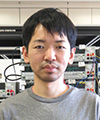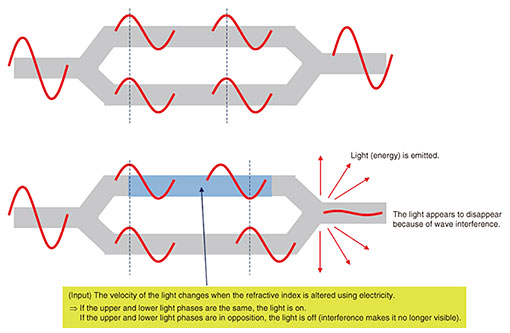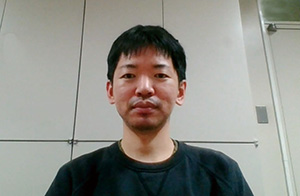 |
|
|
|
|
|
Rising Researchers Vol. 20, No. 3, pp. 6–9, Mar. 2022. https://doi.org/10.53829/ntr202203ri1  Research on Ultra-high-speed Mach-Zehnder Electro-optic Modulators for Long-distance Optical Transmission of 1 Terabit per SecondAbstractWith the proliferation of the Internet of Things and the launch of fifth-generation mobile communication system services, there is a demand for the optical communication networks that support these services to be even faster. In this article, we speak to Distinguished Researcher Yoshihiro Ogiso, who is researching Mach-Zehnder electro-optic modulators: the end points of fiber-optic communication that contribute significantly to higher speed. Keywords: electro-optic modulator, Mach-Zehnder modulator, signal-to-noise ratio Electro-optic modulators convert electrical signals into optical signals—How does an electro-optic modulator work? An easy way to visualize optical communication is to picture a flashlight turning on and off to send Morse code messages from the top of a cliff to a ship. By turning the flashlight on for “1” and off for “0,” it is possible to send a digital signal. Of course, such a signal could not reach the other side of the Earth, so actual optical communication is carried out by passing optical signals through optical fibers. The personal computers and smartphones we use every day are powered by electricity and use electrical signals. Therefore, in order to transmit data via optical communication, electrical signals must be converted to optical signals at some point. This is what electro-optic modulators do. They may sound fairly niche, but they are actually important optical devices that are key to fiber-optic communication. —What are the Mach-Zehnder electro-optic modulators that you are researching? I mentioned earlier about turning a flashlight on and off to send a signal, and that really is the principle of an electro-optic modulator. The simplest method is turning the laser emitter, which is the source of light, on and off. This method is called direct modulation, and is used in optical network units for home use because of its low cost. Another method is to shut off the light by placing something that absorbs light in front of a continuously emitting laser. This is called an electro-absorption modulator. Finally, there is the Mach-Zehnder electro-optic modulator. The Mach-Zehnder electro-optic modulator is constructed so that the light is divided into two at a branch point and then combined, as shown in Fig. 1. Light is a wave, so when the upper and lower light waves overlap as shown in the top image, the phase (the position of the peaks and valleys of the wave) is the same, and so the light is on. On the other hand, if the speed of the light is changed by altering the refractive index in the middle using electricity, as shown in the bottom image, this puts the light waves in opposition, with the peaks and valleys canceling each other out, and so the light goes off. The wave interference means light (energy) is emitted, disappears, and is no longer visible.
While direct modulation and electro-absorption modulator need to consider electron carriers that move at a finite velocity, the Mach-Zehnder electro-optic modulator has the advantage of being able to handle high-speed signals, as it mainly uses electric fields that are less sensitive to carrier movement. —What performance is required from electro-optic modulators? The most important factor for an electro-optic modulator is the signal-to-noise ratio (SNR). The key requirement is converting electrical signals with a high SNR, which means high-quality signals, into optical signals without them degrading. To meet this requirement, electro-optic modulators require three key performance features. The first is a low-voltage drive, which is how sensitive the reaction of light is to weak electrical signals. The second is a high bandwidth, which is also related to sensitivity. This indicates how well high sensitivity can be maintained even at high speeds when switching on and off. And the third is low optical insertion loss. The intensity of the light coming out of the electro-optic modulator corresponds directly to the strength of the signal. No matter how high the sensitivity is, the SNR will drop if the overall output drops, so we need a factor that prevents these losses. These three are trade-offs against each other, and broadening them overall means a competitive advantage for the company. At university I was studying electro-optic modulators made from LiNbO3 (lithium niobate), which was the main material used at the time, but since joining NTT, I have mainly been engaged in research on electro-optic modulators using InP (indium phosphide), a semiconductor material that has low drive voltage, high bandwidth, and can be miniaturized. Enabling long-distance transmission of 1 terabit per second per wavelength—In 2019, the world’s first long-distance transmission of 1 terabit per second per wavelength was successfully demonstrated. Increasing speed requires a number of factors. I worked on the part that converts high-speed electrical signals into high-speed optical signals, NTT Device Technology Laboratories was responsible for the part that produces high-speed electrical signals, and NTT Network Innovation Laboratories was responsible for the processing that restores degraded signals at the destination. The whole of NTT achieved this 1 terabit speed together. There are three ways to speed up an electro-optic modulator. The first is increasing the symbol rate, which simply increases the speed at which light is turned on and off. The second is with higher-order modulation. Only 1 bit of information can be transmitted by turning the light on or off, but if the brightness is set to 0, 0.25, 0.5, 0.75, and 1, for example, it can send a signal like “00001” or “10011.” In addition to the brightness and intensity of the light, quadrature amplitude modulation is currently being developed to transmit a 6-bit or 8-bit signal at one time by dividing the phase of the light as a wave. The third is multiplexing. Light has multiple wavelengths, and even if different colors of light are mixed together and transmitted, they can be divided back up by the receiver. In other words, if you create different colors of light and put an optical signal on each, you can transmit as many signals as there are colors with one fiber. Of these, higher-order modulation and high symbol rate have achieved high speeds, and the electro-optic modulator I created still holds the fastest record in the world. In the past, the speed of electro-optic modulators was plateauing and becoming a bottleneck, so having the most advanced technology in this area is a big advantage for us. —What are the prospects for practical use? At present, demand for the field of communication is very high and competition is fierce. As a result, the cutting-edge research level is almost at the actual development level in this field. NTT Device Innovation Center, where I work, is particularly focused on research that can be put into practical use. I believe our mission is not only to come up with theoretical ideas, but to propose and launch technologies that can be applied to tangible things and reach mass production quickly. The term “valley of death” is often used to refer to a situation in which there are ideas that work well in research, but are difficult to get into the development phase and put into practical use. For example, fabricating InP devices is particularly challenging. InP is a dense material that has alternating indium and phosphorus atoms, so when InP is etched to create a waveguide through which the light of a Mach-Zehnder electro-optic modulator passes, the surface ends up not being very clean. Phosphorus atoms are pulled out, and those parts become a metal-rich indium wall. When another metal is patterned close to those parts, it absorbs the electricity (electric field), which causes the electrical signal to stop passing through. You therefore need specialist knowledge to reduce damage when cutting and make it the way you pictured it, which we call craftsmanship. That said, if it can only be made by a craftsman, it is not suitable for mass sale, so we are currently working on developing wide-margin design documents and specifications that convey a variety of expertise in the process sheets. These will enable mass-production of electro-optic modulators with similar characteristics even when made by external manufacturers. Other production lines are also being considered, and our final goal is to put them into practical use within a few years. —What kinds of possibilities will this technology unlock? In direct terms, it will allow high performance from fifth-generation mobile communication system (5G) services and could be applied to even higher capacity 6G services. It will be effective in data transfer for video streaming, communication between datacenters, and more. It is also expected to be applicable to radio-over-fiber technology, which receives radio waves, transmits them to remote locations via optical communication, then sends them again as radio waves. Electro-optic modulators could also be applied to fields other than communication. In fact, there are many places where electrical signals are converted into optical signals. In the field of sensing, electro-optic modulators are used to generate optical frequency combs (used for measuring the spectra of the frequency components of light) and for gas sensing. In radio observatories, electro-optic modulators are used to process observation data from distant celestial objects. In other cases, light is converted to electricity. For example, in automotive sensors, information sensed by lasers is converted into electrical signals and shown on displays. I suspect there may be a lot more scenarios where a need to convert electrical signals into high-speed, high-quality optical signals arises. I have been conducting research and development in the field of communication, but I would love to develop technologies that can be used in other fields too.
■Interviewee profileYoshihiro Ogiso joined NTT in 2010, where he was assigned to NTT Photonics Laboratories. He was reassigned to NTT Device Innovation Center following reorganization in 2014. Since July 2021, he has also worked for NTT Device Technology Laboratories. Since university, he has been consistently engaged in the research and development of electro-optic modulators. He received a Ph.D. in engineering. |


